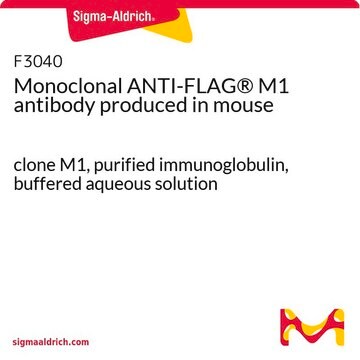F9291
Anticorps monoclonal ANTI-FLAG® M2 antibody produced in mouse
clone M2, purified immunoglobulin, buffered aqueous glycerol solution
Synonyme(s) :
Anti-ddddk, Anti-dykddddk
About This Item
Produits recommandés
Source biologique
mouse
Conjugué
biotin conjugate
Forme d'anticorps
purified immunoglobulin
Type de produit anticorps
primary antibodies
Clone
M2, monoclonal
Forme
buffered aqueous glycerol solution
Espèces réactives
all
Concentration
~1 mg/mL
Technique(s)
dot blot: suitable (chemiluminescent detection)
Isotype
IgG1
Séquence immunogène
DYKDDDDK
Conditions d'expédition
dry ice
Température de stockage
−20°C
Vous recherchez des produits similaires ? Visite Guide de comparaison des produits
Description générale
Application
Antibody is suitable for immunofluorescence, western blotting, microscopy applications and for the formation of avidin-biotin complexes.
Learn more product details in our FLAG® application portal.
Forme physique
Notes préparatoires
Informations légales
Vous ne trouvez pas le bon produit ?
Essayez notre Outil de sélection de produits.
Code de la classe de stockage
10 - Combustible liquids
Classe de danger pour l'eau (WGK)
WGK 2
Point d'éclair (°F)
Not applicable
Point d'éclair (°C)
Not applicable
Certificats d'analyse (COA)
Recherchez un Certificats d'analyse (COA) en saisissant le numéro de lot du produit. Les numéros de lot figurent sur l'étiquette du produit après les mots "Lot" ou "Batch".
Déjà en possession de ce produit ?
Retrouvez la documentation relative aux produits que vous avez récemment achetés dans la Bibliothèque de documents.
Les clients ont également consulté
Notre équipe de scientifiques dispose d'une expérience dans tous les secteurs de la recherche, notamment en sciences de la vie, science des matériaux, synthèse chimique, chromatographie, analyse et dans de nombreux autres domaines..
Contacter notre Service technique















